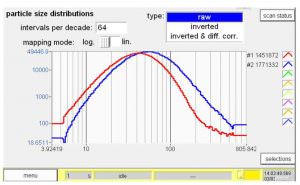- 說明
- 規格
The Palas® DEMC is available in two versions. The version with the long classifying column (2000 model) is able to classify particles in the size range of 8 to 1,400 nm.
The DEMC size classifier (as defined in ISO 15900) selects aerosol particles based on their electrical mobility and directs them to the outlet. It is also often referred to as a DMA.
The Palas® DEMC universally connects to CPCs and aerosol electrometers from other manufacturers. Several counters are already supported (see Figure 4). We will also integrate your counter into the software upon request.
In combination with a polydisperse particle source*, a DEMC is used to obtain a very narrow (monodisperse) particle size distribution for nanoparticles of a certain size. Accurate size determination and reliable performance of the DEMC are extremely important especially for calibration set-ups. The size is adjusted by entering it directly on the touch screen (in nm) or by using the arrow buttons to increase or decrease the size.
If the DEMC is used as a component of an SMPS system, it provides continuous and rapid scanning of the particle size distribution of the aerosol. Based on the user settings, a scan can be performed in as few as 30 seconds or in up to 64 size channels per decade.
The user controls the DEMC using a graphical user interface, which provides linear and logarithmic display of measurement values and data management of the integrated data logger. The software provides sophisticated data evaluation (extensive statistics and averaging) and export capabilities.
The DEMC is typically operated as a stand‐alone device, but can also be connected to a computer or network using various interfaces (USB, LAN, WLAN, RS-232/485).
* Additional information can be found in the product data sheets for the aerosol generators by Palas®, e.g. the DNP 2000, RBG 1000 or AGF 2.0.
Function
Figure 1 presents the principle of operation of the DEMC. The aerosol is conditioned before it enters the DEMC column. A dryer (e.g. silica gel, Nafion) removes moisture from the particles. A bipolar neutralizer (e.g. Kr 85) is used to ensure a defined charge distribution of the aerosol. An impactor at the inlet of the DEMC is required in order to remove particles larger than the classifier size range.

Fig. 1: Principle of operation of the DEMC
The aerosol is then directed into the DEMC column via the inlet. The aerosol flow along the outer electrode is carefully combined here with a sheath air flow. It is important to avoid any turbulence here in order to ensure laminar flow. The surfaces of the electrodes must be of extremely high quality with respect to smoothness and tolerances. This sheath air is a dry, particle-free carrier gas (typically air) with a higher volume than the aerosol that is continuously circulated in a closed loop. The sheath air to sample air volume ratio defines the transfer function and thus the resolution capacity of the size classifier.
A radially symmetric electric field is generated between the inner and outer electrode by applying voltage. The inner electrode is positively charged with a small slit at the end. By balancing the electrical force on each particle with its aerodynamic drag force in the electrical field, negatively charged particles are diverted to the positive electrode. Particles with appropriate electrical mobility pass through the slit and exit the DEMC. These classified particles with the same electrical mobility are then available for use downstream.
If the DEMC is used as a component of an SMPS system, then the voltage and thus the electrical field change continuously and particles of varying mobility exit the DEMC. These are counted consecutively by a nanoparticle counter, such as a condensation particle counter (e.g. Palas® UF-CPC) or an aerosol electrometer (e.g. Palas® Charme®). The tested and optimized Palas® software combines the data (voltage, particle number, etc.) in order to obtain a particle size distribution, as shown in Figure 2.

Fig. 2: Particle size distributions of an aerosol generated by the Palas® DNP 3000 particle generator
User interface and software
Based on continuous customer feedback, the user interface and software have been designed for intuitive operation and real-time control and display of measurement data and parameters.
In addition, the software provides data management with the integrated data logger, sophisticated export capabilities, and network support. The measured data are able to be displayed and evaluated with many available options.
The DEMC software and firmware support the use of nanoparticle counters by other manufacturers. Figure 3 presents an example.

Fig. 3: Screenshot of DEMC counter selection



